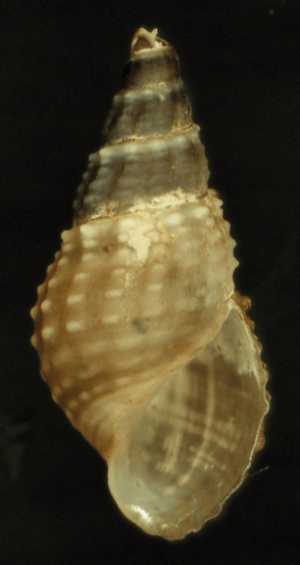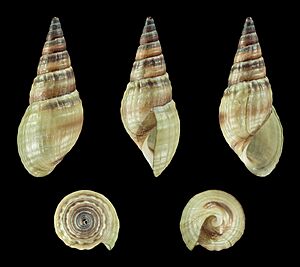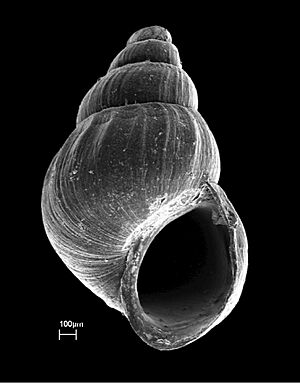Tarebia granifera facts for kids
Quick facts for kids Tarebia granifera |
|
|---|---|
 |
|
| A close-up of an adult Tarebia granifera shell. It is about 22 mm tall. | |
| Scientific classification | |
| Synonyms | |
|
The Tarebia granifera, also known as the quilted melania in the aquarium world, is a type of freshwater snail. It has a special lid called an operculum that can close its shell. This snail is an aquatic gastropod mollusk and belongs to the family Thiaridae.
This snail originally comes from south-eastern Asia. However, it has spread to many other places and is now considered an invasive species. This means it can cause problems for local environments.
Contents
Description
Scientists have studied the body of Tarebia granifera in detail. They also looked at how it lives and behaves.
Adult shells of this snail can be different sizes. In South Africa, they are usually between 18.5 mm and 25.1 mm tall. In Puerto Rico, they can grow even larger, up to 35 mm.
Tarebia granifera snails come in two main colors. One type has a light brown main shell part and a dark tip. The other type is completely dark brown, almost black. You can also find snails with colors in between these two.
Where They Live
Native Homes
This snail naturally lives in many parts of Asia. These areas include India, Sri Lanka, and the Philippines. You can also find them in Hawaii, southern Japan, and Society Islands. Other native places are Taiwan, Hong Kong, and Thailand.
New Homes (Invasive Areas)
Tarebia granifera has become an invasive species on three continents. These are North America, South America, and Africa. It is thought that these snails first spread through the aquarium trade. People bought them as pets and then released them into local waters.
- Americas:
- In the U.S., you can find them in Florida, Texas, Hawaii, and Idaho.
- They are also on many Caribbean islands, such as Puerto Rico and Cuba. In Cuba, it is one of the most common freshwater snails.
- Other islands include the Dominican Republic and Saint Lucia. They have been in Martinique since 1991.
- In Central America, they are found in Mexico.
- In South America, they live in El Hatillo Municipality, Miranda, Venezuela.
- Africa:
- The snail was first reported in South Africa in 1999. It has spread quickly, especially northwards. It is now found in Mpumalanga province, the Kruger National Park, and Eswatini. Scientists expect it to keep spreading to nearby countries.
- Asia:
- It is also found in Israel, where it is not native.
Ecology
Habitat
In South Africa, these snails live in many different places. They are found in rivers, lakes, and even irrigation canals. They also live in concrete reservoirs and garden ponds. They can reach very high numbers, sometimes up to 21,000 snails in one square meter. This high number can affect other native animals living at the bottom of the water.
Most places where they live in South Africa are below 300 meters above sea level. However, they have been found higher up, in rivers around 500 meters. These higher places still have warm water, usually above 24 °C. This suggests that water temperature is important for where they can live.
Tarebia granifera can also live in brackish water. This is water that is a mix of fresh and salt water, like in estuaries. They can even survive in water that is about 28.5% as salty as seawater. They can do this by burying themselves in the mud when the water gets too salty. They come out when fresh water returns.
These snails usually live on the bottom of water bodies. They can be found on sand, mud, rocks, and concrete. They also live among plants like reeds and water lilies. If there are many snails, they might also be found on floating plants like water hyacinth. They like moving water and can handle currents up to 1.2 meters per second.
These snails are often buried in the sediment (mud or sand). About half or more of them might be hidden underground. We don't know how long they can stay buried. They die if the water temperature drops to 7 °C in tanks. In the wild, they don't live in water colder than 10 °C.
Dispersal
Tarebia granifera snails can spread from one water body to another in several ways. Birds, especially waterfowl, might eat them. The snails can then pass through the bird's body and be dropped in a new place. Even if some shells are crushed, some young snails might survive and start a new group.
They can also spread on boats or boat trailers. Water pumped for industry or farming can also carry them. Young snails are often found on floating plants like water hyacinth. These plants act like rafts, carrying the snails downstream quickly.
Once they are in a new water body, they can move actively. They can travel both upstream and downstream in rivers. They can move about 100 meters per month in streams. They can handle fast-flowing water, which helps them spread in many rivers.
Density
The number of Tarebia granifera snails in an area can be very high. In Florida, scientists found about 4,444 snails per square meter. In South Africa, some places had between 843 and 20,764 snails per square meter. The highest numbers were found in still water, shaded by trees and floating plants. Even with so many snails, some native animals were still present, but in very small numbers.
In their native Hong Kong, the snail numbers are much lower, around 18 to 193 per square meter. This shows how much they can multiply when they invade new places.
Scientists are still learning about how their numbers change over time. Some studies show more snails in summer, while others find more in late autumn. The amount of calcium in the water might also affect their numbers.
Feeding Habits
Tarebia granifera snails eat algae, tiny plant-like organisms called diatoms, and detritus (dead plant and animal bits).
Life Cycle and Reproduction
Tarebia granifera snails can reproduce without a male. This is called parthenogenesis. They also give birth to live young, which is called ovoviviparous. These abilities are a big reason why they are so good at invading new places. Even if there are no males, the females can still make babies. Most Tarebia granifera are like copies (clones) of their mother.
The baby snails grow inside a special brood pouch inside the mother. This pouch grows as more babies develop. A mother snail can have between 1 and 77 embryos in her pouch.
Young snails are born through a small opening on the right side of the mother's head. When they are born, their shells are very tiny, less than 1 to 2 mm tall. These newborn snails have a good chance of surviving in the wild.
Snails usually start having babies when their shells reach a certain size. This can be around 8 mm to 12 mm tall. They might start reproducing when they are about five months old. The most babies are born when the mother snail is about 24 mm tall.
Parasites
In their native Asia, Tarebia granifera snails can carry different types of tiny worms called trematodes. Some of these worms can affect fish. One type of worm, Philopthalmus gralli, has been found to affect ostriches on farms. While another snail was first linked to this, the fast-spreading Tarebia granifera could make this problem worse in the future.
For a long time, people thought this snail carried a worm that caused lung problems in humans. However, this was later found to be incorrect.
Other Relationships
Tarebia granifera snails have been linked to the disappearance of other native snails in places like Puerto Rico. They can also push out other types of snails from streams and ponds. Scientists think they might compete for space and food with other animals living at the bottom of the water. When there are many Tarebia granifera, they can change the types of animals found in these areas.
In South Africa, it seems that another native snail, Melanoides tuberculata, is becoming less common. The spread of Tarebia granifera might be the reason. Even though both snails reproduce in similar ways, Tarebia granifera often becomes the most common snail where they live together.
Scientists need to study more to understand the full impact of Tarebia granifera on other species.
Human Importance
Besides carrying some trematode worms, Tarebia granifera can cause problems for people. They have invaded water reservoirs and dams at large industrial sites. When their numbers are very high, they can get pumped into water pipes. This can block the pipes and damage equipment. This happens when the snails are crushed, and their shell pieces and body parts get into the machinery. Young snails can often pass through pumps without harm.




